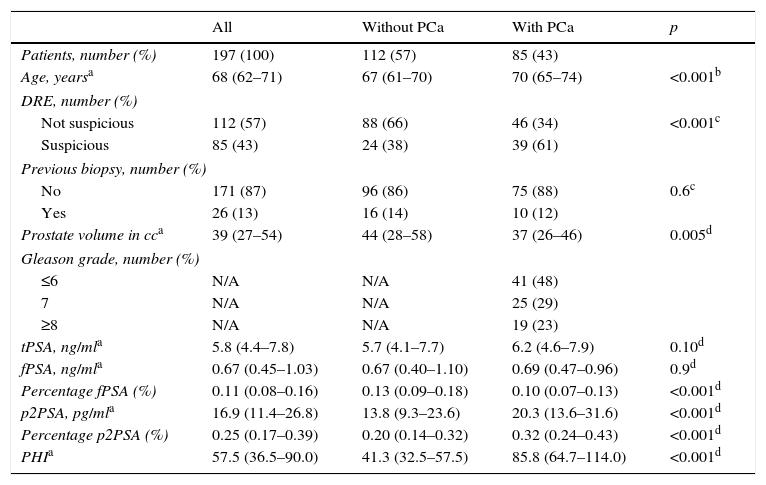To validate and analyze the clinical usefulness of a predictive model of prostate cancer that incorporates the biomarker “[-2] pro prostate-specific antigen” using the prostate health index (PHI) in decision making for performing prostate biopsies.
Material and methodsWe isolated serum from 197 men with an indication for prostate biopsy to determine the total prostate-specific antigen (tPSA), the free PSA fraction (fPSA) and the [-2] proPSA (p2PSA). The PHI was calculated as p2PSA/fPSA×√tPSA. We created 2 predictive models that incorporated clinical variables along with tPSA or PHI. The performance of PHI was assessed with a discriminant analysis using receiver operating characteristic curves, internal calibration and decision curves.
ResultsThe areas under the curve for the tPSA and PHI models were 0.71 and 0.85, respectively. The PHI model showed a better ability to discriminate and better calibration for predicting prostate cancer but not for predicting a Gleason score in the biopsy ≥7. The decision curves showed a greater net benefit with the PHI model for diagnosing prostate cancer when the probability threshold was 15–35% and greater savings (20%) in the number of biopsies.
ConclusionsThe incorporation of p2PSA through PHI in predictive models of prostate cancer improves the accuracy of the risk stratification and helps in the decision-making process for performing prostate biopsies.
Validar y analizar la utilidad clínica de un modelo predictivo de cáncer de próstata que incorpora el biomarcador «[–2] proantígeno prostático específico» a través del índice de salud prostática (PHI) en la toma de decisión para realizar una biopsia de próstata.
Material y métodosSe aisló suero de 197 varones con indicación de biopsia de próstata para la determinación del antígeno prostático específico total (tPSA), fracción libre de PSA (fPSA) y [-2] proPSA (p2PSA); el PHI se calculó como p2PSA/fPSA×√tPSA. Se crearon 2 modelos predictivos que incorporaban variables clínicas junto a tPSA o a PHI. Se evaluó el rendimiento de PHI usando análisis de discriminación mediante curvas ROC, calibración interna y curvas de decisión.
ResultadosLas áreas bajo la curva para el modelo tPSA y el modelo PHI fueron de 0,71 y 0,85, respectivamente. PHI mostró mejor capacidad de discriminación y mejor calibración para predecir cáncer de próstata, pero no para predecir un grado de Gleason en la biopsia ≥7. Las curvas de decisión mostraron un beneficio neto superior del modelo PHI para el diagnóstico de cáncer de próstata cuando el umbral de probabilidad está entre 15 y 35% y un mayor ahorro (20%) en el número de biopsias.
ConclusionesLa incorporación de p2PSA a través de PHI a los modelos predictivos de cáncer de próstata mejora la exactitud en la estratificación del riesgo y ayuda en la toma de decisión sobre realizar una biopsia de próstata.














